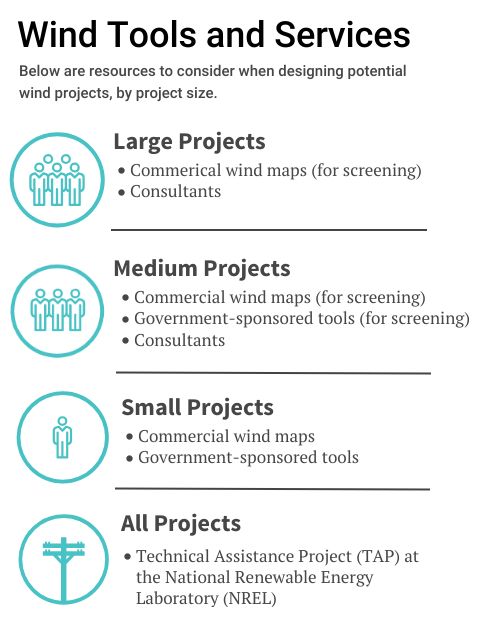[section separator="true"]
[section-item 6]
[row]
[column 12]
Once a wind project has been scoped with regard to its participants and interconnection point—and once the desired finance and ownership approach has been identified—the project enters the predevelopment stage. This stage is focused on improving the understanding of the project design and predicting expected generation. Additionally, the project's regulatory requirements are identified.
The refinement of the project design is influenced by these factors:
- renewable energy resource
- micro-siting of the project within that resource
- availability of land and access to that land
- the presence of threatened and endangered species and habitat near or at the proposed project site
- zoning and permitting context of the site (including federal concerns such as aviation)
[/column]
[/row]
[/section-item]
[section-item 6]
[row]
[column 12]

[/column]
[/row]
[/section-item]
[/section]
Once refined sufficiently, the project design can be shared with potential funding and ownership entities to ensure that their due diligence process has complete information. This transparency is essential for an efficient transition from one project stage to the next.
[well color="primary-dark"]
Deciding on the Developer
As a project progresses from being a concept through the predevelopment stage and into the development stage a choice must be made of who will actually develop the project.
The options for development are informed by the choice of project ownership. If a third party is expected to own the project long-term then it is typical for that third party to perform the project predevelopment and development. If, instead, the cooperative is expected to have an ownership stake--and depending on the size and complexity of the project--the cooperative may elect to perform certain aspects of the predevelopment and development.
Regardless of who actually does the project development, it is important that the cooperative be familiar with the project stages, the elements of each stage, who will performing which element of development, the timeline for the project, and what could affect the pace of development and what the implications and remedies might be for a project timeline that slips.
Deciding on the Developer
As a project progresses from being a concept through the predevelopment stage and into the development stage a choice must be made of who will actually develop the project.
The options for development are informed by the choice of project ownership. If a third party is expected to own the project long-term then it is typical for that third party to perform the project predevelopment and development. If, instead, the cooperative is expected to have an ownership stake--and depending on the size and complexity of the project--the cooperative may elect to perform certain aspects of the predevelopment and development.
Regardless of who actually does the project development, it is important that the cooperative be familiar with the project stages, the elements of each stage, who will performing which element of development, the timeline for the project, and what could affect the pace of development and what the implications and remedies might be for a project timeline that slips.
[/well]
